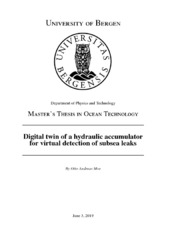Digital twin of a hydraulic accumulator for virtual detection of subsea leaks
Master thesis
Permanent lenke
https://hdl.handle.net/1956/23144Utgivelsesdato
2019-06-14Metadata
Vis full innførselSamlinger
- Master theses [159]
Sammendrag
In cooperation with OneSubsea, this thesis investigates the reasons behind a sudden pressure drop occurring in hydraulic systems during operation of hydraulic accumulators. The thesis also addresses the challenge of detecting and locating leaks in hydraulic systems. A hydraulic system that is located topside on a floating production storing offloading vessel (FPSO) delivers barrier fluid to a subsea processing facility. Hydraulic pumps pressurize the hydraulic fluid, and the pressure energy is stored in high-pressure accumulators. This high-pressure system then delivers hydraulic fluid to a low-pressure system through a valve. From here the hydraulic fluid is stored in low-pressure accumulators, and hydraulic fluid is continuously delivered through an umbilical to a subsea system. As it follows from industrial experience, after pressure charging of the low-pressure accumulators, when the supply valve is being closed, a sudden pressure drop occurs in the corresponding pipeline. This issue has been investigated. In this project, the accumulator has been modeled with the use of Computational Fluid Dynamics (CFD) where the piston-fluid interaction has been accounted for. This has been done by using the overset mesh technique together with Dynamic Fluid Body Interaction method (DFBI) Rotation and Translation, which is embedded in the CFD software Simens Simcenter STAR-CCM+. In a sensitivity analysis, simulation results have been compared with measured data, and a virtual digital twin has been developed, with an average discrepancy of 1.06 % compared with measured pressure data set 3. This virtual digital twin with a smooth friction shift has been seen as the best alternative to be taken further for leak detection assignments. This thesis closes with a summary of the conducted simulations, and suggestions for future work to improve the virtual model.
